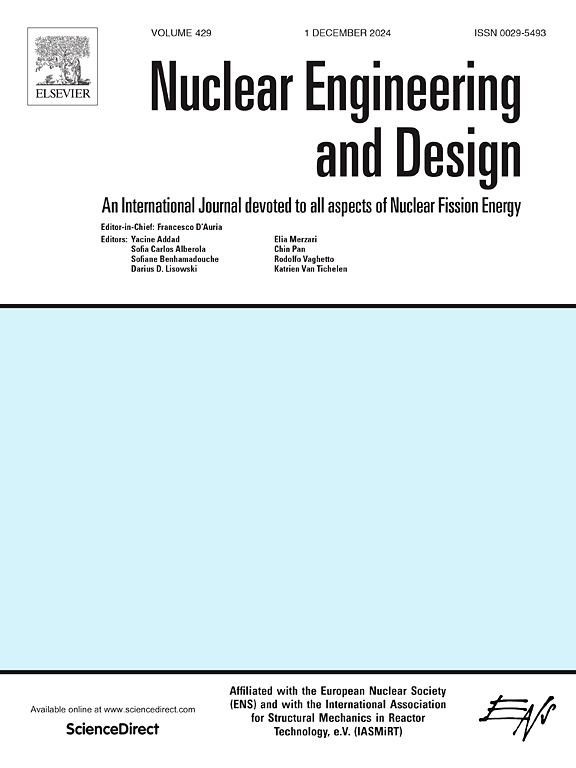Thermal-hydraulic optimization of a closed-jet trans-critical hydrogen moderator with non-uniform heat sources using machine learning and multi-objective algorithms
IF 1.9
3区 工程技术
Q1 NUCLEAR SCIENCE & TECHNOLOGY
引用次数: 0
Abstract
The optimization of heat transfer in transcritical hydrogen moderators, such as the Decoupled Poisoned Hydrogen Moderator (DPHM) at the China Spallation Neutron Source (CSNS), is critical for enhancing neutron flux and ensuring the safe operation of spallation neutron sources. This study addresses the unique thermal–hydraulic challenges posed by closed-jet impingement and non-uniform internal heat sources in transcritical hydrogen systems, which are essential for maintaining efficient neutron moderation and thermal stability. A three-dimensional computational model is developed to investigate the effects of key design parameters, including the flow baffle offset (L), inlet jet height (H), and hydrogen mass flow rate (m), on heat transfer and flow dynamics. Leveraging a genetic algorithm-optimized backpropagation (BP) neural network, this work introduces an innovative predictive framework to capture the complex nonlinear relationships between these parameters and system performance. Furthermore, a multi-objective optimization approach combining NSGA-III and TOPSIS is employed to identify optimal operating conditions that balance cooling efficiency and flow velocity constraints. The results demonstrate the critical role of jet impingement in mitigating thermal stratification and improving heat transfer, offering significant insights for the design and optimization of hydrogen moderators in advanced nuclear systems. This study not only advances the understanding of transcritical hydrogen behavior under non-uniform heat sources but also provides a practical, machine learning-enhanced methodology for optimizing thermal–hydraulic performance in spallation neutron sources.
基于机器学习和多目标算法的非均匀热源闭式射流跨临界氢慢化剂热液优化
中国散裂中子源(CSNS)解耦毒化氢慢化剂(DPHM)等跨临界氢慢化剂的传热优化是提高散裂中子源中子通量和保证散裂中子源安全运行的关键。该研究解决了跨临界氢系统中封闭射流撞击和不均匀内部热源所带来的独特热工挑战,这对于维持有效的中子中速和热稳定性至关重要。建立了一个三维计算模型,研究了流动挡板偏移量(L)、进口射流高度(H)和氢气质量流量(m)等关键设计参数对传热和流动动力学的影响。利用遗传算法优化的反向传播(BP)神经网络,这项工作引入了一个创新的预测框架,以捕捉这些参数与系统性能之间复杂的非线性关系。此外,采用NSGA-III和TOPSIS相结合的多目标优化方法,确定了平衡冷却效率和流速约束的最佳运行工况。研究结果表明,射流撞击在缓解热分层和改善传热方面发挥着关键作用,为先进核系统中氢慢化剂的设计和优化提供了重要见解。这项研究不仅促进了对非均匀热源下跨临界氢行为的理解,而且为优化散裂中子源的热工性能提供了一种实用的、机器学习增强的方法。
本文章由计算机程序翻译,如有差异,请以英文原文为准。
求助全文
约1分钟内获得全文
求助全文
来源期刊

Nuclear Engineering and Design
工程技术-核科学技术
CiteScore
3.40
自引率
11.80%
发文量
377
审稿时长
5 months
期刊介绍:
Nuclear Engineering and Design covers the wide range of disciplines involved in the engineering, design, safety and construction of nuclear fission reactors. The Editors welcome papers both on applied and innovative aspects and developments in nuclear science and technology.
Fundamentals of Reactor Design include:
• Thermal-Hydraulics and Core Physics
• Safety Analysis, Risk Assessment (PSA)
• Structural and Mechanical Engineering
• Materials Science
• Fuel Behavior and Design
• Structural Plant Design
• Engineering of Reactor Components
• Experiments
Aspects beyond fundamentals of Reactor Design covered:
• Accident Mitigation Measures
• Reactor Control Systems
• Licensing Issues
• Safeguard Engineering
• Economy of Plants
• Reprocessing / Waste Disposal
• Applications of Nuclear Energy
• Maintenance
• Decommissioning
Papers on new reactor ideas and developments (Generation IV reactors) such as inherently safe modular HTRs, High Performance LWRs/HWRs and LMFBs/GFR will be considered; Actinide Burners, Accelerator Driven Systems, Energy Amplifiers and other special designs of power and research reactors and their applications are also encouraged.
 求助内容:
求助内容: 应助结果提醒方式:
应助结果提醒方式:


